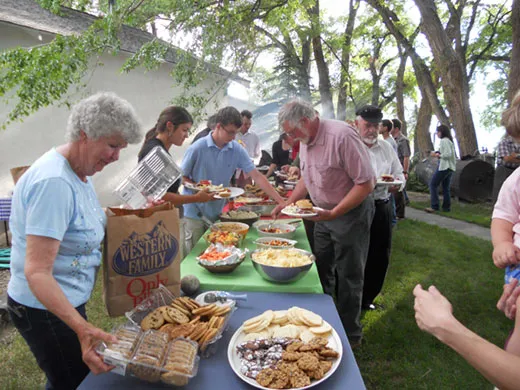Wyoming Paleontology Dispatch #4: Paleontologists’ Summer Family
Mired in the mud? Need an emergency place to stay? The Churchill family has helped out for more than 80 years
/https://tf-cmsv2-smithsonianmag-media.s3.amazonaws.com/filer/Wyoming-Dispatch-Churchills-picnic-631.jpg)
Fossil collecting typically is a pretty solitary exercise. Even with three or four people working in a small quarry, many minutes or even hours can slide by with few sounds but the swish of wind in the sagebrush and the musical plink of hammers tapping rocks. I like to think we are silent because we are focused intently on scanning each bedding plane as it is exposed, hoping that some tiny fleck of brown or orange will resolve itself into the detailed impression of a delicate flower, fruit or leaf. It is also a time for silent contemplation, on topics and people near or far.
This silent time may make paleontological crews a little more eager than they otherwise would be for a bit of social time, and there is one “don’t miss” event on the social calendar for fossil hunters working in the Bighorn Basin—the Fourth of July picnic at the home of the Churchill family in Powell, Wyoming. This year my crew has arrived in the field a bit later than usual, and we really don’t deserve a day of rest and relaxation after only three days of work, but I’m not going to miss the chance to see so many friends and colleagues, and especially the Churchills themselves.
Winston and Beryl and their three sons, Tom, Todd and Coy, have been hosting a Fourth of July barbeque for fossil hunters and farmers since before I first came to the Bighorn Basin in 1972. It was Winston’s grandparents who first extended hospitality to paleontologists working in the Bighorn Basin back in the 1920s, when it was hard to find a reliable supply of drinking water. Since then four generations of Churchills have helped out paleontologists in need. Mired in the mud 20 miles from the nearest road? Need an “emergency” place to stay for yourself and your six-person field crew for a month? Broken down in your aging field vehicle in an isolated gulch? Can’t get your trailer-tent out of a steep patch of badlands? Want help finding a great fossil locality or a friendly connection to a local landowner? Need advice on a good place to catch trout? The Churchill family has helped Bighorn Basin paleontologists with these things and many others for more than eight decades. For those of us who have been working in the area for many years they are also a summer family when we are far from home.
The Fourth of July barbecue at the Churchill’s is an opportunity to meet and talk with people from Powell, and also to talk casually with colleagues about our science. Many a collaboration and future Ph.D. thesis has been born of a conversation in the Churchill’s side yard, as a hot, sunny Fourth of July day turns into a beautiful cool evening. Sometimes local collectors bring finds for the professionals to identify, and sometimes we are even able to help them! I don’t know of anything quite like this get-together—a hybrid of family reunion, international professional conference and neighborhood picnic.
This year I’m excited to see Elwyn Simons and Friderun Ankel Simons. Elwyn, a specialist in the fossil record of primates, the group of mammals to which we belong, was the person who first introduced me to the Bighorn Basin that long-ago summer of 1972. We have a mini-reunion with two other members of that same crew, vertebrate paleontologists Ken Rose and Tom Bown.
Besides the discussion of recent discoveries and ideas, this year there is also quite a bit of talk about the upcoming Bighorn Basin Coring Project—something several of us are involved in. The project, conceived and pushed forward by our colleague Will Clyde of the University of New Hampshire, involves drilling into rocks deposited during the Paleocene-Eocene Thermal Maximum and a slightly later period of globally warm climate that goes by the amusing nickname “Elmo.” The drill has teeth around the leading edge and a hollow center. As we drill, a column of rock rises into the center of the pipe. If we’re lucky, we retrieve a solid tube of rock five feet long.
We paleontologists may have a lot of experience finding fossils and studying the surface geology here, but we know almost nothing about coring, so there is some anxiety mixed with the anticipation of doing something new. The possible benefits of the coring project are very large: the cores will consist of unweathered rock that we think preserves microscopic and molecular fossils not found in surface samples. Each core will also give us a vertical column of rocks many hundreds of feet high (albeit in many five-foot-high pieces) and thus be a record of what happened in a single place through time.
Ordinarily we have to piece together our records from many places, because no one spot exposes such a deep cut through rocks of the right age. The cores will be pure time machines, without the complexities introduced by combining records of change from many places. The benefits of the project are potentially very high, but we all know it is a risk as well—none of us has cored before, we don’t know if we will be able to raise the cores without damaging or contaminating them, and there is the logistical challenge of scheduling the efforts of dozens of people to work round-the-clock for several weeks. July will be an exciting and nerve-wracking month.
Scott Wing is a research scientist and curator in the Smithsonian Institution’s Department of Paleobiology.
/https://tf-cmsv2-smithsonianmag-media.s3.amazonaws.com/accounts/headshot/SLW_photo_-James_Kegley_for_Smithsonian.jpg)

/https://tf-cmsv2-smithsonianmag-media.s3.amazonaws.com/accounts/headshot/SLW_photo_-James_Kegley_for_Smithsonian.jpg)